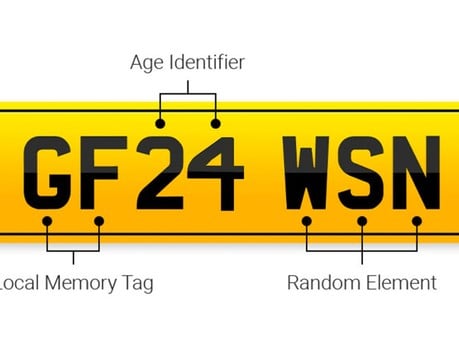Number Plate Guide
How Does the Number Plate System Work in the UK? Read our 2024 update
Car enthusiasts often look forward to March and September of each year. Why? Because it’s in these months that the latest batch of cars roll off production lines and into showrooms.
Registration plates are also subject to updates, so vehicles released from March adopt the year they’re produced in, while those produced from September 2020 onwards adopt a number in the 70s to signify a new decade (see the table below). In 2024, new car number plates will either have ‘24’ or ‘74’ printed on them.
March and September are the months in which car manufacturers typically release the latest version of the cars in their line-up. This could mean that a model is getting a major facelift or redesign, or it could be a small update to include an additional feature. For many buyers, this is the ideal time to secure a brand new vehicle.
In this guide dedicated to registration plates in the UK, we explain how the number plate system works, what the reg is for 2024 and this year’s banned number plates. Read on to find out more…
UK Number Plates Explained
The current number plate system we use in the UK was first introduced in September 2001. Registration plates are laid out to display two letters, followed by two numbers, then by another three more letters. An example of 2024 number plates might be AB24 CDE or AB74 CDE.
The number on the plate refers to the year and six-month period in which the vehicle was first registered; either March to August or September to February. The age identifier changes on 1st March and 1st September every year. The table below shows how the age identifier changes over the life of the current number plate format.

The March codes are easier to remember and identify because they follow the year of the registration. For example, a car that has been registered from March 2024 will have the number 24 as its age identifier. For cars registered between September and February, the code is the year (as of September) plus 50. Therefore, cars produced from September 2024 to February 2025 will have the number 74 as their age identifier. Similarly, 2025 number plates will feature 25 and 75 as their age identifiers.
What do the number plate letters stand for?
The first two letters are known as the ‘local memory tag’ and they show where the vehicle was registered. The first letter represents the region and the second letter represents a local DVLA office. For example, a vehicle registered in London will have a number plate starting with LA through to LY. 'Z' is only used as a random letter, never designated to a particular area code.
The last three letters are chosen randomly and are allocated to a dealership when the car is registered. The random nature of these letters and specific allocation to a dealership gives each vehicle a unique identity. For a full breakdown of local memory tags and where cars were initially registered, take a look at the table below and refer to the official DVLA (Driver & Vehicle Licensing Agency) Vehicle registration numbers and number plates leaflet.
Registration Plate Guide
From the year 2001 when the number UK number plate system was introduced, to the current 2024 registration plate and everything in between:
| Year | 1st March - August End | 1st September - February End |
| 2001/02 | 51 | |
| 2002/03 | 02 | 52 |
| 2003/04 | 03 | 53 |
| 2004/05 | 04 | 54 |
| 2005/06 | 05 | 55 |
| 2006/07 | 06 | 56 |
| 2007/08 | 07 | 57 |
| 2008/09 | 08 | 58 |
| 2009/10 | 09 | 59 |
| 2010/11 | 10 | 60 |
| 2011/12 | 11 | 61 |
| 2012/13 | 12 | 62 |
| 2013/14 | 13 | 63 |
| 2014/15 | 14 | 64 |
| 2015/16 | 15 | 65 |
| 2016/17 | 16 | 66 |
| 2017/18 | 17 | 67 |
| 2018/19 | 18 | 68 |
| 2019/20 | 19 | 69 |
| 2020/21 | 20 | 70 |
| 2021/22 | 21 | 71 |
| 2022/23 | 22 | 72 |
| 2023/24 | 23 | 73* |
| 2024/25 | 24 | 74* |
*and so on until 55/00
Number Plate Area Codes UK
The local memory tag element of a number plate allows a vehicle to be identified by the region in which it was first registered. Every area in the UK is assigned an indicator code by the DVLA, distinguished by two capital letters - these are as follows:
First Letter | UK Region | Postal Area | Memory Tag Identifier |
A | Anglia | Peterborough Norwich Ipswich | AA AB AC AD AE AF AG AH AJ AK AL AM AN AO AP AR AS AT AU AV AW AX AY |
B | Birmingham | Birmingham | BA-BY |
C | Cymru | Cardiff Swansea Bangor | CA CB CC CD CE CF CG CH CJ CK CL CM CN CO CP CR CS CT CU CV CW CX CY |
D | Deeside to Shrewsbury | Chester Shrewsbury | DA DB DC DD DE DF DG DH DJ DK DL DM DN DO DP DR DS DT DU DV DW DX DY |
E | Essex | Chelmsford | EA-EY |
F | Forest & Fens | Nottingham Lincoln | FA FB FC FD FE FF FG FH FJ FK FL FM FN FP FR FS FT FV FW FX FY |
G | Garden of England | Maidstone Brighton | GA GB GC GD GE GF GG GH GJ GK GL GM GN GO GP GR GS GT GU GV GW GX GY |
H | Hampshire & Dorset | Bournemouth Portsmouth and the Isle of Wight | HA HB HC HD HE HF HG HH HJ HK HL HM HN HO HP HR HS HT HU HV HW HX HY (HW will be used exclusively for Isle of Wight residents) |
K | East Midlands & Hertfordshire | Borehamwood Northampton | KA KB KC KD KE KF KG KH KJ KK KL KM KN KO KP KR KS KT KU KV KW KX KY |
L | London | Wimbledon Sidcup | LA LB LC LD LE LF LG LH LJ LK LL LM LN LO LP LR LS LT LU LV LW LX LY |
M | Manchester & Merseyside | Manchester and the Isle of Man | MA – MY (MN + MAN Reserved for the Isle of Man) |
N | North | Newcastle Stockton | NA NB NC ND NE NG NH NJ NK NL NM NN NO NP NR NS NT NU NV NW NX NY |
O | Oxford | Oxford | OA-OY |
P | Preston | Preston Carlisle | PA PB PC PD PE PF PG PH PJ PK PL PM PN PO PP PR PS PT PU PV PW PX PY |
R | Reading | Theale | RA-RY |
S | Scotland | Glasgow Edinburgh Dundee Aberdeen Inverness | SA SB SC SD SE SF SG SH SJ SK SL SM SN SO SP SR SS ST SU SV SW SX SY |
V | Severn Valley | Worcester | VA-VY |
W | West of England | Exeter Truro Bristol | WA WB WC WD WE WF WG WH WJ WK WL WM WN WO WP WR WS WT WU WV WW WX WY |
Y | Yorkshire | Leeds Sheffield Beverley | YA YB YC YD YE YF YG YH YJ YK YL YM YN YO YP YR YS YT YU YV YW YX YY |
How often do new number plates come out?
New number plates are released twice a year in the UK as standard practice on the 1st of March and September. The main reason that new number plates are released is to: 1) cater for the amount of cars and vans being produced each year to ensure there’s enough combinations of letters and numbers, and 2) to show how old a vehicle is and help make the car or van easily identifiable.
What is the new reg for 2024?
In line with the year itself, 2024 introduces a ‘24’ number plate from the 1st March and a ‘74’ number plate from the 1st September. Example number plate combinations would be ‘NU24 REG’ which features on new cars registered from 1st March 2024 until the 31st August 2024, followed by ‘NU74 REG’ which features on new cars registered from 1st September 2024 until the end of February 2025.
2024 Banned UK Number Plates
Of course, not all number plates follow the standard set of rules - they can also be personalised too. Check out our dedicated ‘Rules of Personalised Number Plates’ blog to understand more.
In line with personalised registration plate options, comes a whole heap of red tape too. Are you aware that the DVLA releases a list of banned number plates every year? This is usually because the letter and number combinations are too offensive and inappropriate to be used.
Let’s take 2024 for example. This year, another set of x-rated and offensive number plate combinations have been blacklisted due to their insensitive nature. It goes without saying that rude and inappropriate combinations of number plate letters and numbers are also banned - no matter how cheeky you think they may be! Nobody wants to be sat behind a driver with the number plate TE24 ROR or F24 RTS…we’ll leave the remaining banned combination to your imagination.
If you opt for a personalised number plate, keep it sensible by choosing from the millions of options available via the DVLA website.
Electric Vehicle Number Plates
With the growing number of electric vehicles (EVs) on the roads, you will no doubt have noticed that the registration plate looks slightly different to that of a standard petrol or diesel car. We often get asked the question, ‘why do number plates have green on them?’ - the simple answer being that it is to show the vehicle in question is electric.

First introduced by the UK Government in 2020 to raise awareness of zero emission vehicles, electric cars are fitted with number plates that have a green ‘flash’ on the left-hand side. Dubbed ‘green number plates’, only vehicles with zero emissions at the tailpipe qualify for these. Green number plates are now fitted as standard to all new EVs, but you can request to opt for a standard registration plate instead if you prefer.
Order Your New Car From Wilsons Epsom
As the largest family-run new car supermarket in the South of England, here at Wilsons in Epsom, Surrey, we proudly represent 11 new car brands…
Discover the latest models from Abarth, Alfa Romeo, Fiat, Jeep, Hyundai, Nissan, Nismo, Peugeot, MG, Renault and Dacia, including our hybrid and electric vehicle offering.
We have a whole host of offers available on a selection of new models across the range. You can view our new car stock online and book a test drive at our state-of-the-art multi-franchise dealership nestled between London and the Surrey Hills. Visit us today!




